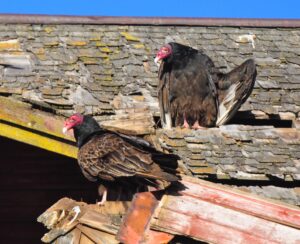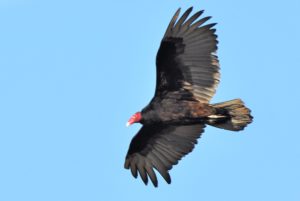Photography courtesy of Lowell Washburn, all rights reserved.
One robin may not make a spring, but when the turkey vultures return to Max Clausen’s barn, you can rest assured the season has changed. Clausen’s barn is located on The Nature Conservancy’s Clausen’s Cove Area which adjoins Clear Lake’s south shore. For the past five years, vultures have returned to make their nests in the barn’s now abandoned hay loft, making the species one of the region’s newest signs of spring.

The phenomena is not unique to northern Iowa. Elsewhere across the state, the traditional cavity nesters are learning to adapt to the wooden platforms and forgotten hay bales found in abandoned barns, cribs and other rural outbuildings. This, combined with more blacktop roadways and increased numbers of vehicle killed wildlife are thought to be major contributors to the vulture’s northward expansion.
With its sooty plumage, featherless red head, and dour demeaner, most folks probably wouldn’t list turkey vultures as a favorite bird. Beyond appearances, the species’ scavenging lifestyle does little to elevate the image. Serving as Chief Scavenger, the birds routinely deal with some extremely nasty food items; with ripening road kills providing a significant portion of the diet. But the daily intake is not limited to what creatures were too slow at crossing the highway. I once observed several well filled vultures emerge from inside the heat-burst carcass of a bloated Holstein – it was an unforgettable sight.
But although their dining habits may seem repulsive, vultures aid in sanitizing the countryside and help suppress the spread of disease — particularly to domestic animals.
In the process of consuming carrion, vultures also ingest wholesale quantities of potentially dangerous bacteria. To survive the ordeal, the scavengers employ a unique 108-degree digestive system that effectively cooks and destroys any living organisms that may happen to slide down their gullets — including such nasties as cholera, anthrax, salmonella and E.coli.
Although vultures have keen eyesight and may locate food while soaring at great heights, they also have a very advanced sense of smell. Unlike other birds, they have the ability to track down a meal by simply following their noses.
Whether a vulture depends most heavily on its keen vision or acute sense of smell is an ongoing topic of debate. Although I can’t answer that question, I did have one memorable encounter that made me wonder. It occurred several years ago while hunting spring gobblers among some rugged Iowa blufflands. After hours of negotiating some particularly rough terrain, I finally gave in to what had become a unseasonably warm and beautiful spring morning. Stretching out in a sun-drenched clearing, I quickly fell fast asleep. Sometime later, I was awakened by the sound of flapping of wings. Opening my eyes, I was greeted to the intense stare of an adult vulture standing less than a dozen feet away. To me, it appeared as if the feathery scavenger had been sizing me up as a potential meal. Upon discovering that I was still very much alive, the huge bird lumbered back into the sky.
I still think about that big vulture from time to time. Like I said, the day was unseasonably warm, and I had been climbing a number of steep ridges. Although I’ll never know what led that bird in my direction, I’ve always hoped that it was guided by its eyes and not its nose.


 Tom Cope
Tom Cope Sue Wilkinson
Sue Wilkinson Susan Judkins Josten
Susan Judkins Josten Rudi Roeslein
Rudi Roeslein Elyssa McFarland
Elyssa McFarland Mark Langgin
Mark Langgin Adam Janke
Adam Janke Joe Henry
Joe Henry Kristin Ashenbrenner
Kristin Ashenbrenner Joe Wilkinson
Joe Wilkinson Dr. Tammy Mildenstein
Dr. Tammy Mildenstein Sean McMahon
Sean McMahon